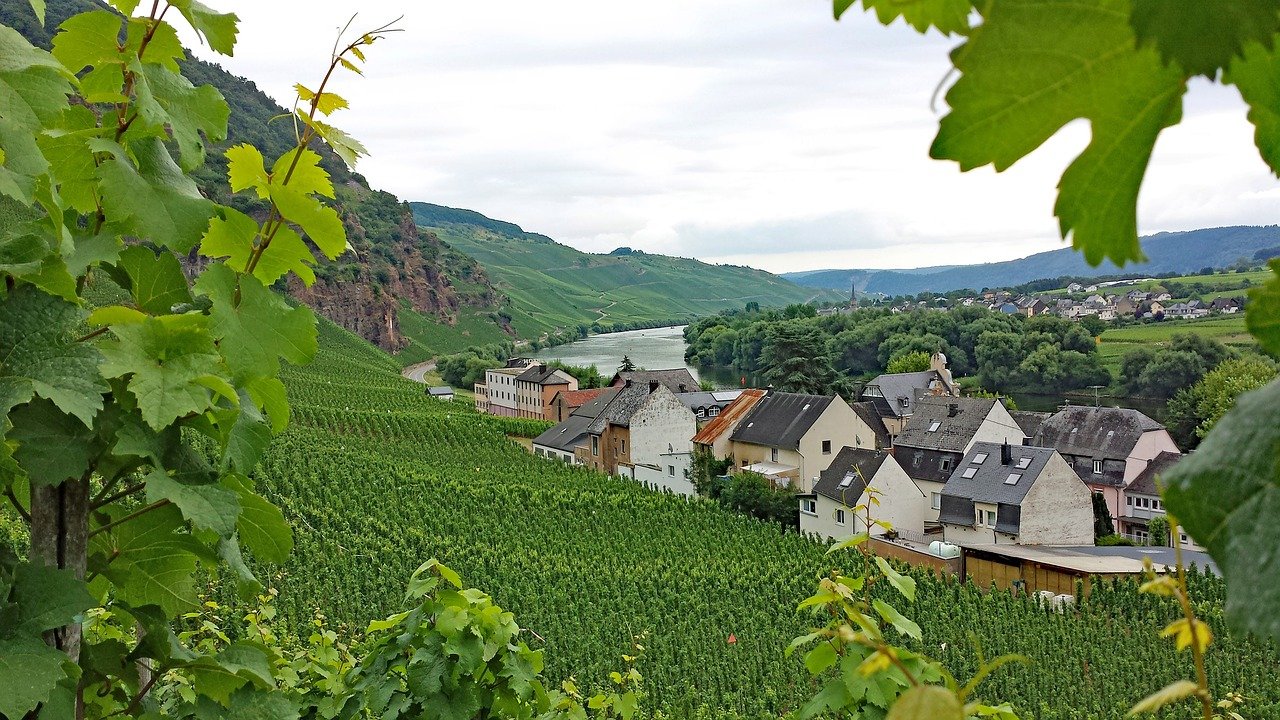Don’t feel bad if you didn’t get to go on a trip to Europe this summer. Enjoy a wine and gastronomy tour of Germany with good German wine – in your own kitchen, on the veranda or in your favourite restaurant.
German wines – gastronomic, light and fresh, so they are ideal for romantic dinners, and for evening gatherings with friends. Today not only Rieslings are imported into Russia, but also various other German varieties – Spätburgunder (German Pinot Noir), Silvaner, Müller Turgau, Grauburgunder (German Pinot Gris), Weissburgunder (German Pinot Blanc) and others. And they all make up an entire summer wine list in any café or restaurant – so gastronomic and appropriate for different tastes and price ranges. Not surprisingly, an entire festival, Riesling Weeks 2021, takes place from July 1 to August 31 in 42 cities across Russia.
Germany’s different regions have not only unique attractions and regional characteristics, but also their own top wines. Let’s get to know the most famous ones.
Rheingau
Start with the great German river, the Rhine, and Germany’s oldest wine-growing region, the Rheingau, home to Johannisberg Castle and the Eberbach Monastery, with its iconic vineyards and top wines. Traditionally, fine Rieslings and top-class Spätbergunder are produced here.
A regional classic is the Rheinischer Sauerbraten (Rheinisch Sauerbraten), a marinated meat roast. It is served with red cabbage, apple mousse and potato dumplings.
North Sea mussels and Rhenish wine come together to create a classic local dish – mussels steamed with vegetables (Muscheln rheinische), seasoned with garlic and allspice, served with rye bread and butter.
Moselle
This region is called the kingdom of Riesling and is quite picturesque – light, mineral, flowery and fruity Riesling is made from grapes growing on the slopes of the Rhine. The main attractions on the Moselle are the ancient Roman town of Trier and the huge number of castles and monasteries. The first vines were planted here by the ancient Romans 2,000 years ago! Of particular fame is Mount Calmont, the steepest vineyard in Europe.
The Mosel specialties are the undisputed favourites of the popular German open pie: apple pie (Apfelkuchen) and plum pie (Zwetschgenkuchen). Plum slices or halves are cleverly arranged on a prepared layer of shortbread or yeast dough. Sometimes they are sprinkled with a crumble of sour cream, butter, sugar and flour. The finished cake is garnished with icing sugar and served with whipped cream.
Rheinhessen
Germany’s largest wine-growing region, dominated by Riesling, but also producing sylvaner and Müller Turgau. The closer the vineyard is to the Rhine, the better its soil is suited to wine. The local soft wines, made mostly for sale outside the region, are known as Liebfraumilch (“Milk of the Beloved Woman”). For themselves, local winemakers prefer to make dry sylvaner.
The region’s main dishes are “Heaven and Earth” and “False Hare”. “Earth apples” (Erdäpfel), as potatoes (“earth”) are often called in Germany, but also apples (“sky”), blood sausage and fried onion rings are the ingredients of the traditional Cologne dish “Heaven and earth” (Himmel un Ääd).
“Since the middle of the 19th century, the Falscher Hase is a meatloaf made of minced meat, finely chopped onions, and a bun soaked in milk. You put a layer of fried carrots and 3-4 hard-boiled eggs inside. Oven-baked roulade can often replace rabbit or hare roast for the holiday table.
Palatinate
The historic region along the Rhine River called the Palatinate is the second largest wine region in Germany. Bad Dürkheim is home to the largest wine festival in the world and the largest wine barrel in the world. There is also the German Wine Route (Deutsche Weinstraße), an 85 kilometre long route through the Palatinate, the first of its kind in Germany. It runs along the border with France, passing through 130 wine-growing villages.
The Pfalz is also an important producer of red wines and Riesling wines, but the white wines of note here include Müller Turgau, as well as the Weissburgunder, Grauburgunder, Gewürztraminer and Scheurebe.
A gastronomic speciality of the Palatinate is the stuffed stomach called “Pfalzer Saumagen”. Former German Chancellor Helmut Kohl used to feast on it, stuffing it with several kinds of meat, boiled potatoes, eggs, spices and aromatic herbs. Another favourite dish is the Dibbelabbes, a dish made of shredded potatoes, cured meat and leeks, cooked in a “dibbe”, as the locals call it, in a pot.
Franconia
The region is situated in the valley of the river Main and the main city of Franconia is Nuremberg, once the capital of the Third Reich. Locals divide Franconia into a beer region (Bier Franken) in the south and a wine region (Weinfranken) in the north along the slopes of the vineyards on the river Main. The region is renowned for the stubbornness of its inhabitants: they insist on using Bocksbeutel, awkward flask-shaped bottles that are difficult to stack in the cellar. Another local speciality is the preference for sylvaner wine over Riesling, the mainstay of the German wine scene.
Bavarian specialities are served here. For example, tarte flambé (Flammkuchen), a pizza-like pastry made with thin dough. The traditional filling is white cheese with bits of onion and bacon, but you can also have chicken, fish, sausages and mushrooms. Schäufele (a slice of pork shoulder with a crispy crust) with potato dumplings and Bamberg onions are also popular.
There are many fish dishes in Germany: they are served stewed, smoked, or boiled. The mirror carps were bred here and have been caught in the local ponds since the 12th century. Carp can be used for a variety of dishes, such as baked carp or roasted carp with vegetables.
Baden
Baden is Germany’s southernmost region, with a hot climate for Riesling, which is why other white grape varieties like Rulander (aka Pinot Gris), Müller-Thurgau and Gewürztraminer are popular here. Baden is home to the well known thermal springs, the extinct volcano Kaiserstuhl and the casino where Dostoevsky lost all his money.
The cuisine in Baden is varied. The first course is Flädlessuppe, a soup with pancakes, which resembles a clear beef broth with thin, sliced pancakes. For hot food, you’re more likely to get a meat dish in Baden – it’s tender here, with detachable fibres, just melts in your mouth. Everything is delicious – veal (Kalb), pork (Schwein), lamb (Lamb), deer (Hirsch), roe deer (Reh). The game is cooked very fast, it stays even more raw than the home beef, but turns out very tender and tasty.
For dessert the dampfnudel, a German steamed bun typical of southern German and Austrian cuisine and the French Alsace, is served. The pastry is interesting because it is not cooked in an oven but in a pan, usually filled with milk and sugar. The inside can be stuffed with plums. The buns are generously sprinkled with vanilla sauce.
Württemberg
In this region where Stuttgart and Heilbronn are located, wine is considered a kind of folk beverage. Per capita consumption is twice the German average. The most common variety is trollinger.
Traditional Swabian cuisine is based on simple, hearty and easy to prepare meals, the so-called “poor man’s food”. Highlights of Swabian cuisine include egg dumplings in different variations, such as spätzle and maultaschen, as well as hearty soups, potato dishes and Eintopf. Swabian cuisine is renowned for its many regional varieties of bread, cheese and sausages, as well as baked goods, desserts and drinks.
Swabian monks are believed to have invented a method of “hiding” food from the eyes of the Almighty by hiding desirable but not always permitted (meat) in… dough. The legendary Maultaschen, Swabian-style dumplings stuffed with meat, fish, mushrooms, curd, are eaten simply boiled, fried or in vegetable broth.
The most Swabian and “always successful” apple pie is Apfelkuchen with “sunken” apples (Apfelkuchen). It is made with a puff pastry (butter, sugar, a pinch of salt, eggs, flour and baking powder) in which quarters of apples are “sunk”.
Saxony
The region, whose capital is Dresden, produces mostly sparkling wines. On the last weekend in August, 25 of Saxony’s wineries hold an open house where you can get to know the producers and taste the speciality wines.
This is where one of Germany’s most popular dishes is made, pea soup with roasted or boiled sausages (Erbsensuppe). The region is also famous for its quarkkäulchen, an unusual name that literally translates as ‘curd balls’. Pan fried ‘dumplings’ made from mashed potatoes, cottage cheese and eggs gradually become ‘fritters’. Sometimes they are made only of curd, and eaten with smoked delicacies as well as for dessert – with jam, honey, apple puree or icing sugar.
Germans are big fans of smoked foods. The Kasseler, a traditional roast pork roast in Lower Saxony, is served with stewed vegetables and root vegetables: carrots, rutabagas and parsnips. The vegetables are flavoured with cream.

